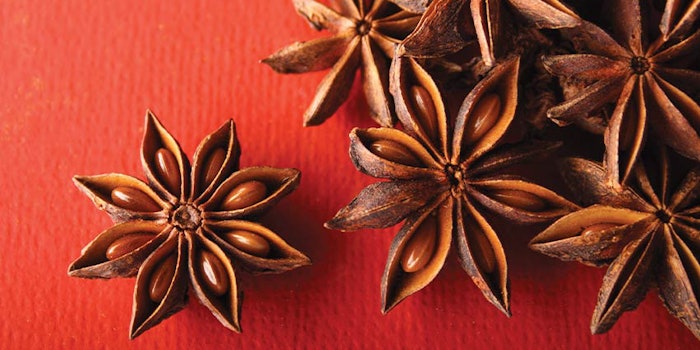
Familiar chemicals that are highly characteristic of a specific, very easily recognized aroma tend to get overlooked outside the obvious categories. Anethole, also known as 1-methoxy 4(prop-1-enyl) benzene, (FEMA# 2086, CAS#104-46-1) is a case in point. It is instantly recognizable as aniseed. Aniseed notes are a driver of liking in a number of categories and considerable quantities of anethole are used in oral hygiene and mint blends, as well as licorice and root beer flavors. Outside these obvious aniseed categories this chemical can be surprisingly useful in a wide range of flavors at much lower levels of addition, adding subtle nuances that are not remotely recognizable as aniseed.
Note that the dose rates given throughout this article are the levels suggested for use in flavors intended to be dosed at 0.05% in ready-to-drink beverages or in a simple bouillon.
Brown Flavors
Chocolate: 50 ppm of anethole gives a very attractive twist to chocolate flavors without adding an obvious aniseed note. Higher levels are also attractive but mainly serve to distinguish specific brands and can get close to being intrusive.
Coffee: In a similar way, levels of addition around 40 ppm, can deepen and intensify coffee flavors.
Honey: Honey flavors vary radically. 5 ppm is a safe level of addition in very light, floral honey flavors but three or four times this level can be a better option in more substantial honey flavors, such as clover.
Licorice: I don’t think anethole makes any significant contribution to the character of licorice roots, but licorice has always been associated with significant additions of aniseed oil or anethole. A good starting point is 8,000 ppm.
Root Beer: Root beer flavors have always used widely varying levels of anethole but, once sassafras was banned, anethole served the additional function of toning down the aggressively dominant methyl salicylate. A cautious starting point is 2,000 ppm.
Vanilla: Vanilla flavors vary even more than rum flavors. Anethole is highly compatible with French style vanilla flavors and can be used at levels from 70 ppm up. More authentic bean style flavors can also gain added depth from this ingredient but a much more modest level, around 20 ppm. By now regular readers of this column may be beginning to suspect that my vanilla bean flavors contain far too many ingredients – they might be right.
Tea: Black and red tea flavors benefit from around 80 ppm of this ingredient. The ideal level in green tea flavors varies with the profile but 20 ppm is a reasonable starting point.
Fruit Flavors
Apple: Apple flavors can easily tend to be light and insubstantial. The addition of around 50 ppm of anethole adds depth and impact without contributing an intrusive spice note.
Apricot: This chemical blends very well with the lactone notes in apricot flavors and can enable higher additions of key lactones. 30 ppm works well in fresh apricot flavors but slightly higher levels, up to 50 ppm, are better in dried apricot flavors.
Banana: In a similar way, anethole forms a very harmonious blend with eugenol in banana flavors and adds realism at levels of addition in the region of 20 ppm.
Blackberry: Modest additions of anethole work well in a berry flavors, adding depth. 30 ppm is a good starting point in blackberry flavors.
Blackcurrant: 20 ppm of anethole gives a pleasant twist to realistic blackcurrant flavors but the sky is the limit in artificial, buchu-based, confections.
Blueberry: Higher level of this ingredient, up to 60 ppm, add depth and impact to all types of blueberry flavors.
Cherry: Cherry flavors can, like blackcurrant flavors, be considered as two separate groups. The ideal level of addition for realistic flavors is around 10 ppm. Flavors dominated by benzaldehyde can tolerate several times this level.
Cranberry: Anethole blends well with the mildly cheesy notes in cranberry flavors. The ideal level of addition is 30 ppm.
Grape: This ingredient adds very little to floral white grape flavors but a touch, around 10 ppm, serves to round out Concord grape flavors.
Mango: 30 ppm of anethole adds depth to mango flavors and takes some of the edge off the dominant terpene mango skin top notes.
Peach: As with apricot, 20 ppm additions of this chemical blend very well with the central complex of lactones.
Pear: Pear flavors can suffer from the same lack of substance and depth as apple flavors, and anethole can exert a similarly useful effect at 20 ppm.
Raspberry: 20 ppm of anethole adds a pleasant depth to raspberry flavors, blending especially well with zingerone.
Rhubarb: Many rhubarb flavors find it difficult to avoid being a one note chord, dependant on one highly characteristic chemical, strallyl acetate (which is not actually found in rhubarb). The most obvious second note is vanillin, but this can also leave a very simplistic flavor. Anethole takes some of the edge off the vanillin note at around 20 ppm.
Strawberry: Anethole works better in ripe strawberry styles than in very green profiles. The best level is 40 ppm.
Other Flavors
Brandy and whiskey: Anethole blends well into all spirit flavors, helping to give them body and depth. 10 ppm is a good level in brandy, Cognac and all whisky flavors.
Celery: As little as 10 ppm of anethole adds extra impact and interest to celery flavors, working equally well with cooked and raw profiles.
Cheese: This ingredient is beneficial in all cheese flavors but especially in those types where the process involves heating, such as cheddar, Gruyere and Parmesan. The ideal level of addition in cheddar and Gruyere flavors is 30 ppm; in Parmesan flavors it is 50 ppm.
Dill: Anethole steps out of the shadows and into the limelight in dill flavors. Levels of 300 ppm and up work superbly, especially in dill pickle flavors.
Smoke: 20 ppm of this chemical softens the phenolic notes in smoke flavors, blending especially well with eugenol.
Rum: Of all spirit flavors anethole is most at home in rum flavors. The best level of addition depends on the type of rum—40 ppm in dark rums and 20 ppm or less in light rums.
Tomato: Anethole can help to round out both cooked and raw tomato flavors. 20 ppm is a good place to start.
Walnut: A very modest addition, 10 ppm and lower, can produce interesting effects in all nut flavors, but anethole is most effective in walnut flavors. 60 ppm is a good level.











